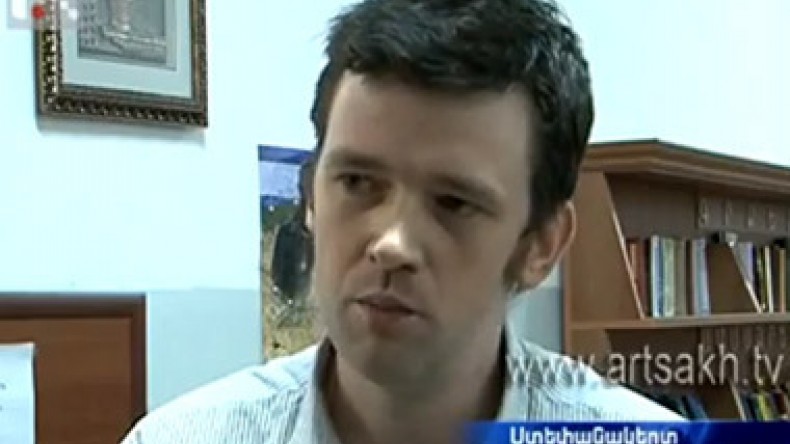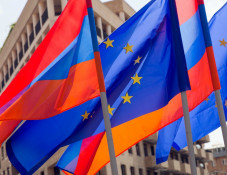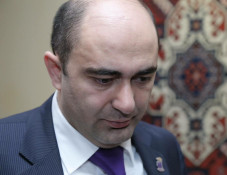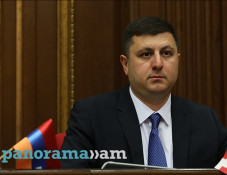
Balint Kovacs: Ramil Safarov’s issue is disposition of Hungarian Government, but not ordinary Hungarians
"The issue of Ramil Safarov is a subject of broad discussions in Hungary. This is the disposition of our government, not just the Hungarians. I hope this would not become a stumbling block in our further relations," yesterday in an interview with the reporters stated scientist of Armenian Studies from Hungary Dr. Balint Kovacs after a meeting with the Armenian and Hungarian students at Artsakh State University.
As the “Karabakh-open.info” reports, Balint Kovacs leads a group of students who arrived in Armenia and Artsakh with a 10-day get-to-know visit, during which they met with Armenian students. During the meeting at Artsakh State University Hungarian students read reports about the Armenian-Hungarian relations, Armenians, who contributed to the freedom of Hungary, the Armenian Diaspora’s activities in Hungary and other topics. Speeches of Artsakh students concerned the current stage of Armenian-Hungarian relations.
"I am a lecturer and, of course, I cannot take political decisions, but I hope that our politicians will find a way to resolve the situation.
This issue is evidence to the fact that the Armenians and Hungarians are friends, and their friendship must go on," he said, continuing the topic of Ramil Safarov’s extradition from Hungary to Azerbaijan.
As the Artsakh TV notes in its video footage http://artsakhtv.am/am/news/show/5382, Kovacs noted that the extradition of Safarov was not a right step, and it should be corrected.
He also stated that the Armenian-Hungarian relations have a long history: a strong Armenian community has formed in Hungary since the late middle Ages, and there were four Armenian cities in Transylvania. He mentioned that these Armenian cities contributed to the development of the region. In addition, he said that Armenians served in Hungarian troops, generals in that number, and they had fought for Hungary.
He noted that the Armenian culture has a big influence on Hungary: an exhibition was organized in Budapest last summer; the ancient Armenian Bible kept in the library of Transylvania was presented at the exhibition as well as Karabakh carpets.
"Karabakh is an integral part of the Armenian culture. I believe Christianity unites Armenians and Hungarians, and my students, whether Catholic or Orthodox, are here by the traces of faith. To get acquainted with the Armenian culture, we found it appropriate to visit not only Armenia, Tatev, but also Artsakh – Gandzasar and Shushi. We will continue the study of Armenian history in Hungary, and in the future, I am sure our students will choose as a topic for their research works the history of Armenia, Artsakh and Nakhichevan, which is part of Armenia," concluded Hungarian professor of Armenian Studies.
In 2004, Armenian officer Gurgen Margaryan was taking part in a three-month English course of NATO “Partnership for Peace” in Budapest. Early in the morning of February 19 he was murdered. The murderer – Azerbaijani officer Ramil Safarov - delivered 16 blows of ax to the face of the sleeping Armenian officer. As a result, the Hungarian court found him sane and sentenced him to life imprisonment without a right of pardon for 30 years. The news about the extradition of Ramil Safarov to his homeland and pardon by the Azerbaijani president Ilham Aliyev broke out on August 31.
Because of Safarov’s extradition to Azerbaijan the president of Armenia Serzh Sargsyan announced the suspension of diplomatic relations with Hungary.
Safarov’s extradition, pardon, and glorification in Azerbaijan was condemned by the US president Barack Obama, US State Department, Ministries of Foreign Affairs of Russia and France, Secretary General of Council of Europe, Secretary General of CSTO, NATO, and international human rights organizations. In addition to that, European Parliament adopted a condemning resolution on September 13, 2012.
Newsfeed
Videos






























